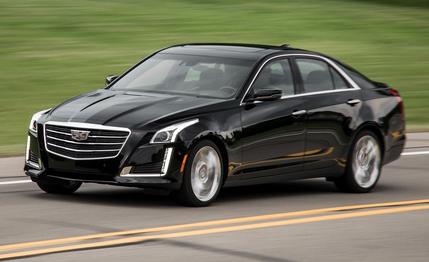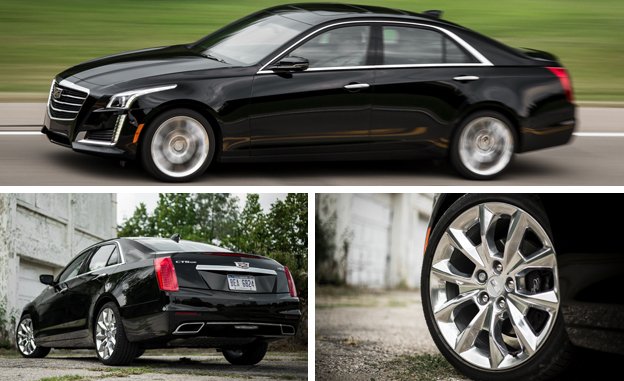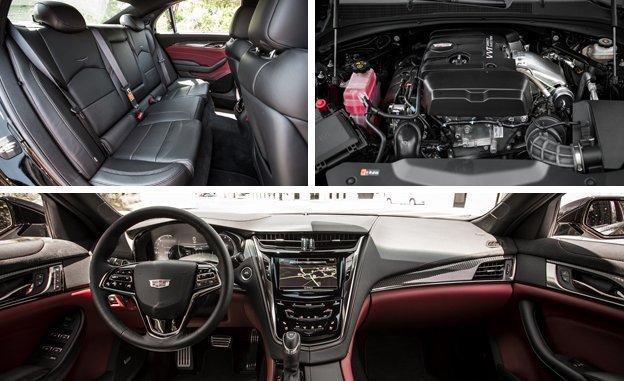 Instrumented Test
Instrumented Test
If any product deserves the lion’s share of credit for Cadillac’s ever-ongoing renaissance, it’s the CTS. It was a promising sports sedan when it debuted for 2003, but it took the refinements of the second generation launched five years later before it really delivered. Recognizing this, we named the CTS to our 10Best list in 2008, 2009, and 2010. The third generation—introduced for 2014—continued the trend, a 10Bester again for 2014 and 2015.
For 2015, the CTS couldn’t have rested on its laurels even if it wanted: Part of the tweaks it received included a new Cadillac crest stripped of its familiar wreath. That brings us to 2016, where the big news is the replacement of the 2.0T’s six-speed automatic with a new eight-speed.

Cadillac says fuel-economy savings of five percent are possible when you combine the stop-start technology also added this year with the eight-speed’s wide overall ratio and slightly taller top gear. More important, the quicker first-gear ratio of 4.62:1 (versus 4.06:1) will help drivers “start off more confidently, with a greater feeling of immediate performance.” Undaunted by puffery that sounds like a pull quote from a Viagra ad, we tested a new CTS to validate these claims.
A one-to-one comparison between old and new wasn’t possible, as the 2016 CTS 2.0T tested here had all-wheel drive and the 2014 2.0T we tested was rear-drive. It’s worth pointing out that the cars proved to be nearly identical on the skidpad, however, with the 2014 pulling 0.83 g versus the 2016’s 0.84. In terms of braking, the 2014 required 164 feet to stop from 70 mph against the 2016’s 177 feet, the difference likely due to the 185-pound weight advantage of the rear-drive 2014, with perhaps a small hat tip to its Pirelli P Zero Nero rubber. (The 2016 also was shod with Pirellis, but they were Cinturato all-season run-flats.)
The 2014 CTS had a marginally greater output of 272 horsepower—this year, the 2.0T makes 268 due to a new powertrain calibration. Torque remains unchanged at 295 lb-ft. Off the scales and on the track, this year’s CTS shrugs off its penalties. Essentially running even with its older sibling up to 40 mph—thanks, all-wheel-drive launch traction!—the 2016 pulls away by 60 mph, getting there in 5.8 seconds, a 0.4-second improvement over its predecessor. New dispatches old in the quarter-mile, too; it’s 0.3-second quicker at 14.5 seconds, although its trap speed of 94 mph is slower by 1 mph.
How about fuel economy? The EPA rating for the 2014 CTS with all-wheel drive is 19 mpg city and 28 mpg highway; for 2016, the EPA estimates the all-wheel-drive CTS at 21/29. We achieved 18 mpg in this test, 1 more than we saw from the RWD 2014 car.
Once in the driver’s seat, you’ll find the same magnesium, steering-wheel-mounted shift paddles as before, and they’re as pleasing to use as they are to behold. (Chevrolet needs to score these for the automatic-transmission Corvette, like, immediately.) As with most other GM automatics, you select manual mode by pressing a button on the gear lever, and manual shifts here are paddle-only. Left to its own devices, the transmission’s shifts are smooth but a tad slow for our taste; manual shifts are similar in quality.
The chassis, it must be said, remains exemplary. The ride and handling balance is best in segment with or without the magnetic dampers of our test car, the steering lively and immediate even with power going to the front wheels, and the brakes have consistent tactile feedback. The CTS loves to play, and it dives into and through corners with an alacrity and confidence that shames many other so-called sporty cars. It is, quite simply, the best car to drive in its class, with a stiff structure and body control to rival a yoga master. If you love to drive, stop reading here and head to a Cadillac dealer.

If you need further information before making a decision, however, know that the CTS now boasts a standard rearview camera and enhancements to CUE, including the addition of Apple CarPlay and Android Auto. A high-definition, reconfigurable 12.3-inch TFT gauge cluster is standard on the 2.0T Premium model or is available as part of the Performance Seat and Cluster package, an $1830 option. What the cluster offers in configurability, it loses in readability for the tachometer, fuel, and coolant-temperature gauges. While these are actual physical dials, they are sliver-thin crescents and as difficult to read as an old-fashioned thermometer.
The rest of the interior continues to have a few too many materials in the mix, including more piano-black trim than is perhaps wise for anyone who disdains dust or fingerprints. Smartly, Cadillac has begun to simplify its interior design language a bit with the new CT6, but more could be done to ramp up the sophistication and truly compete in the upper strata of luxury, which is where Cadillac has priced its newest cars.
The all-wheel-drive CTS with the Premium package carries a base sticker of $63,680. Add in black leather with red accents ($1500) and 19-inch polished-aluminum wheels ($1050), and you reach our car’s hefty total of $66,230. It’s worth pointing out, however, that the CTS 2.0T AWD starts at $48,555 against the BMW 528i xDrive’s $53,495 and the Audi A6 2.0T Quattro’s $49,325. So the CTS is competitive.
Cadillac continues to polish the gem that is the CTS, and the new transmission makes a fantastic car quicker and a bit more fuel-efficient. It’s too bad that buyers are staying away from the Cadillac in droves—they’re missing out on automotive greatness.